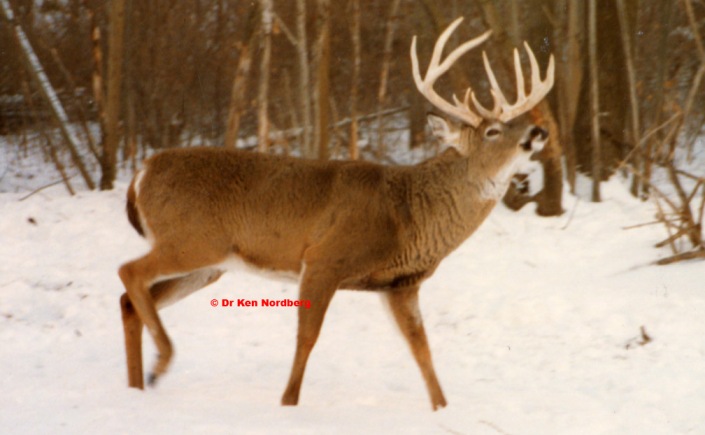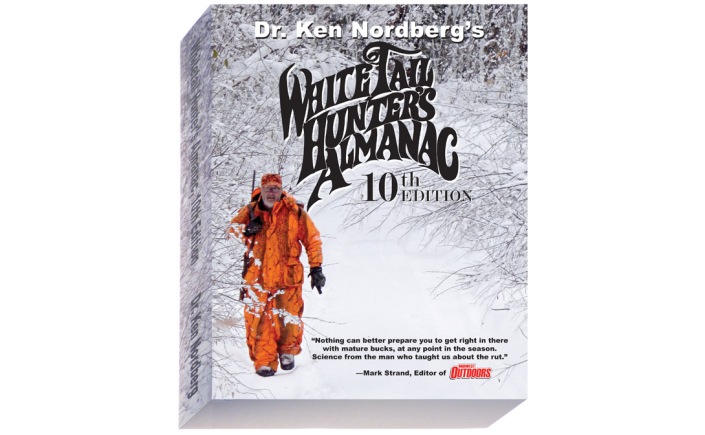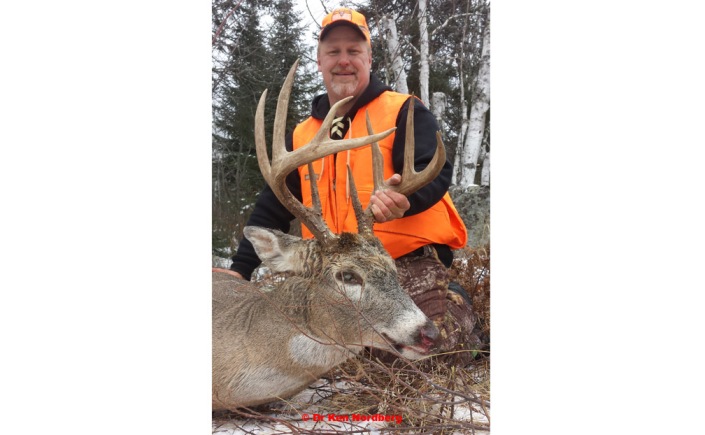My Whitetail Hunters Almanac, 10th Edition is the most comprehensive book about whitetails and whitetail hunting I have ever written. It took three years to write it. Each of my first nine Almanacs, written between 1988 and 1997, covered 1–3 different hunting-related subjects learned from my year-round wild whitetail field studies over much of America. Via my 2nd Edition, I was first to accurately describe the whitetail rut. My 10th Edition, likely my last Almanac because I am now 83, includes portions of most important subjects from each those early Almanacs along with the enormous amount of new information learned from my ongoing studies between 1997 and 2017, including six new, mature-buck-effective hunting methods culminating with “opportunistic stand hunting,” the most productive buck hunting method I have ever known. These new hunting methods enabled my three sons and I to take 98 mature bucks since 1990, nearly one each per year on public land inhabited by overabundant gray wolves which have kept deer numbers low. You have to admit this is pretty amazing unguided buck hunting anywhere, especially in a state where only one buck could be taken per hunter per year.
The creation of this book evolved from ten turning points during my 73 years of whitetail hunting. The first came in 1945 when I began hunting deer. A little more a decade earlier it was discovered our whitetails could no longer keep pace with year around hunting by our burgeoning American human population. To preserve our much revered heritage of deer hunting, America being a nation of deer hunters who necessarily lived off the land for three centuries, concerned hunters and politicians of that time devised a means of restoring, conserving, protecting and funding deer management while allowing continuing hunting by citizens to keep deer populations, which can double annually, within the carrying capacities of their ranges. Thus deer hunting became a sport rather than subsistence hunting, characterized by new principals such as “sportsmanship, ethics” and “fair chase hunting (hunting in a manner that does not give the hunter an unfair advantage over deer).” Therefore today, I am yet a serious advocate of “sportshunting” and all it means.
During my first 15 years of whitetail hunting, I was a member of a group of relatives and neighbors that hunted deer by making drives only. We commonly took 12 deer per hunting season, but very rarely a mature buck. When I asked my Uncle Jack why this was so, he said, “You have to be in the right place of the right time to take a big buck.” When I then asked, “Where is the right place at the right time, “ he laughed and said, “I don’t know, but when you are there, you’ll certainly know it.” With that thought in mind, I became determined to somehow find right places at right times for taking mature bucks in the future. My first serious effort began in 1970, intended to ensure the first two of my children would take bucks during their first “bucks only” hunting seasons. By this time I was well prepared to begin scienttically-based research, having three related college degrees and years of being involved in research at the University of Minnesota. What I initially learned about wild whitetails not only enabled all five of my children to take trophy bucks during their first hunts, but it was also so fascinating that such research became a year around avocation.
In 1980 I decided I should begin sharing what I had learned with other hunters by becoming an outdoor writer and seminar speaker. I had several reasons for doing this. For one, I had discovered only about half of American whitetail hunters took a deer each year, roughly 90% of which were fawns and yearlings. Moreover, most hunters were fortunate to take only 1–2 trophy bucks in a lifetime. At this point I knew I could change all this.
Beginning in1945 I butchered all deer taken by myself, my children, my father, and my other hunting partners (with their help) until one exceptionally warm hunting season in 1972 when it was necessary to rush the buck I had taken to a nearby butcher shop. After inspecting many of the other deer hanging in his cooler, I was appalled by how many had been hit multiple times in non-fatal parts. Considering how many hunters were then then making make drives or still-hunting (wandering about on foot), it was likely most of their quarries were fleeing away at top speed through dense cover when fired at, logically making such wounds as common as they were. Never being notably successful at taking bounding deer myself during the many years I helped make drives, after beginning my hunting-related research in 1970, it became one of my most urgent goals to learn how to hunt in a manner that would provide opportunities to fire at unsuspecting deer standing or moving slowly short distances away. In time I created six new ways to do this and it is therefore now my goal to teach as many hunters as I can to use these same unusually productive hunting methods.
Another reason for sharing what I was learning reoccurred multiple times to in the area where members of my family had been hunting whitetails since 1902. Many who hunted in this region obviously knew little about predictable whitetail habits and improved ways to hunt these deer. Three groups of such hunters hunted in three adjacent areas 1-3 miles east of where us Nordbergs hunted. Because by the 1980s my hunting partners and I had become known for regularly taking mature bucks only, many of them trophy-class bucks, and because those other hunters very rarely saw such bucks, much less take one, they came to the conclusion all older bucks in the region obviously lived only in the area the Nordberg’s hunted. In time they could stand it no longer. Upon deciding they had as much right to hunt those bucks, living on public land, as we did, they began still-hunting, making drives and using primitive tree stands, including ours, big time throughout our hunting area. In the process they quickly drove all deer into large adjacent spruce bogs and alder swamps, We thus moved to a new study/hunting area more than 100 miles away in 1990. Some years later while presenting seminars at a Deer Classic in St. Paul, one of those hunters stopped at my booth to ask where we were we were once again regularly taking mature bucks. Mum on this subject, he then said, “We found out why you guys abandoned your old hunting area. You shot all the big bucks. We haven’t seen one in that area since you left.”
Knowing I could now teach other hunters how to use new mature-buck-effective hunting methods that would enable any serious deer hunter to regularly take unsuspecting bucks or other deer with easy, humane shots at deer standing or moving slowly short distances away, I began sharing everyting I had learned in 1980. Since then I have written more than 800 articles about whitetails and whitetail hunting for various outdoor magazines, two per month for Midwest Outdoors throughout the past three decades. I’ve written 12 bestselling deer hunting books. including my very recently published Whitetail Hunters Almanac, 10th Edition. I have created a number of videos, including the very popular 12-hour series entitled Whitetail Hunter’s World, published in 1986 (no longer available). I presented hundreds of deer hunting seminars nationwide and personally taught hundreds of hunters from all over the US at my annual Buck and Bear hunting Schools in the wilds of northern Minnesota. I’ve been a prolific blogger, tweeter and more recently I’ve also become a popular deer hunting seminar speaker on YouTube, now with about 400,000 visits (growing fast) with great reviews during the past year. My website is also loaded with copies of past magazine articles.
Of all the ways I’ve been sharing what I’ve learned about whitetails and how best to hunt them, no one source today can beat my 8” x 10”, 518-page, 3-pound Whitetail Hunters Almanac 10th Edition with its 400 photos and instructive diagrams. Though it would probably take an extra year to master Opportunistic Stand Hunting, any of my other five mature-buck-effective hunting methods introduced in this book can provide any serious whitetail hunter with opportunities to take mature unsuspecting bucks or other deer within amazingly short range this very fall. Don’t waste another deer hunting season dependent on beliefs that were never true about whitetails or beliefs that are no longer true because whitetails that have survived three of more hunting seasons are no longer as vulnerable to old traditional hunting methods as they once were, including stand hunting as done by most stand hunters today. Begin the best whitetail hunting or the best buck hunting of your life today by purchasing my new book. For more information about my 10th Edition and how to easily order an autographed copy that will arrive with a valuable free gift within a few days, go my website at http://www.drnordbergondeerhunting.com and then click on “store.” I guarantee you will be forever glad you did.
Best of luck hunting this fall!
Normal
0
EN-US
JA
X-NONE
/* Style Definitions */
table.MsoNormalTable
{mso-style-name:”Table Normal”;
mso-tstyle-rowband-size:0;
mso-tstyle-colband-size:0;
mso-style-noshow:yes;
mso-style-priority:99;
mso-style-parent:””;
mso-padding-alt:0in 5.4pt 0in 5.4pt;
mso-para-margin:0in;
mso-para-margin-bottom:.0001pt;
mso-pagination:widow-orphan;
font-size:12.0pt;
font-family:Cambria;
mso-ascii-font-family:Cambria;
mso-ascii-theme-font:minor-latin;
mso-hansi-font-family:Cambria;
mso-hansi-theme-font:minor-latin;}










